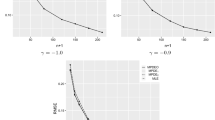Abstract
Estimating the location and scale parameters of a distribution is one of the most crucial issues in Statistics. Therefore, various estimators are proposed for estimating them, such as maximum likelihood, method of moments and minimum distance (e.g. Cramér-von Mises—CvM and Anderson Darling—AD), etc. However, in most of the cases, estimators of the location parameter \(\mu \) and scale parameter \(\sigma \) cannot be obtained in closed forms because of the nonlinear function(s) included in the corresponding estimating equations. Therefore, numerical methods are used to obtain the estimates of these parameters. However, they may have some drawbacks such as multiple roots, wrong convergency, and non-convergency of iterations. In this study, we adopt the idea of Tiku (Biometrika 54:155–165, 1967) into the CvM and AD methodologies with the intent of eliminating the aforementioned difficulties and obtaining closed form estimators of the parameters \(\mu \) and \(\sigma \). Resulting estimators are called as modified CvM (MCvM) and modified AD (MAD), respectively. Proposed estimators are expressed as functions of sample observations and thus their calculations are straightforward. This property also allows us to avoid computational cost of iteration. A Monte-Carlo simulation study is conducted to compare the efficiencies of the CvM and AD estimators with their modified counterparts, i.e. the MCvM and MAD, for the normal, extreme value and Weibull distributions for an illustration. Real data sets are used to show the implementation of the proposed estimation methodologies.


Similar content being viewed by others
References
Acitas S, Arslan T (2020) A comparison of different estimation methods for the parameters of the Weibull Lindley distribution. Eskisehir Teknik Üniv Bilim ve Teknol Dergisi B Teorik Bilimler 8(1):19–33
Acitas S, Senoglu B (2020) Robust change point estimation in two-phase linear regression models: an application to metabolic pathway data. J Comput Appl Math 363:337–349
Acitas S, Filzmoser P, Senoglu B (2020) A new partial robust adaptive modified maximum likelihood estimator. Chemom Intell Lab Syst. https://doi.org/10.1016/j.chemolab.2020.104068
Akgül FG, Senoglu B (2018) Comparison of estimation methods for inverse Weibull distribution. In: Trends and perspectives in linear statistical inference. Springer, Cham, pp 1–22
Ali S, Dey S, Tahir MH, Mansoor M (2020) The comparison of different estimation methods for the parameters of flexible Weibull distribution. Commun Fac Sci Univ Ank Ser A1 Math Stat 69(1):794–814
Bakouch HS, Dey S, Ramos PL, Louzada F (2017) Binomial-exponential 2 distribution: different estimation methods with weather applications. Tend Mat Apl Comput 18(2):233–251
Basu A, Shioya H, Park C (2011) Statistical inference-the minimum distance approach. CRC Press, New York
Boos DD (1981) Minimum distance estimators for location and goodness of fit. J Am Stat Assoc 76(375):663–670
Boos DD (1982) Minimum Anderson-Darling estimation. Commun Stat Theory Methods 11(24):2747–2774
Chen G, Balakrishnan N (1995) A general purpose approximate goodness-of-fit test. J Qual Technol 27(2):154–161
Donoho DL, Liu RC (1988) The automatic robustness of minimum distance functionals. Ann Stat 16(2):552–586
Duchesne T, Rioux J, Loung A (1997a) Minimum Cramér-von Mises distance methods for complete and grouped data. Commun Stat Theory Methods 26(2):401–420
Duchesne T, Rioux J, Loung A (1997b) Minimum Cramér-von Mises estimators and their influence function. Actuar Res Clear House 1:349–361
Hoeffding W (1953) On the distribution of the expected values of the order statistics. Ann Math Stat 24(1):93–100
Kantar Y, Senoglu B (2008) A comparative study for the location and scale parameters of the Weibull distribution with given shape parameter. Comput Geosci 34:1900–1909
Louzada F, Ramos PL, Perdona GS (2016) Different estimation procedures for the parameters of the extended exponential geometric distribution for medical data. Comput Math Methods Med 2016:12
Puthenpura S, Sinha NK (1986) Modified maximum likelihood method for the robust estimation of system parameters from very noise data. Automatica 22:231–235
Swain JJ, Venkatraman S, Wilson JR (1988) Least-squares estimation of distribution functions in Johnson’s translation system. J Stat Comput Simul 29(4):271–297
Tiku ML (1967) Estimating the mean and standard deviation from a censored normal sample. Biometrika 54:155–165
Tiku ML, Akkaya AD (2004) Robust estimation and hypothesis testing. New Age International (P) Limited Publishers, New Delhi
Vaughan DC (1992) On the Tiku–Suresh method of estimation. Commun Stat Theory Methods 21(2):451–469
Acknowledgements
The authors would like to thank the reviewers for their valuable comments and suggestions which improved the paper.
Author information
Authors and Affiliations
Corresponding author
Ethics declarations
Conflict of interest
The authors declare that they have no conflict of interest.
Additional information
Publisher's Note
Springer Nature remains neutral with regard to jurisdictional claims in published maps and institutional affiliations.
Appendix
Appendix
Let \(x_{1}, x_{2}, \ldots , x_{n}\) be independent random variables from a cdf F(x). Without loss of generality, the location parameter \(\mu \) and scale parameter \(\sigma \) in dF(x) are assumed to be 0 and 1, respectively. Furthermore, \(x_{(1)} \le x_{(2)} \le \cdots \le x_{(n)}\) denote the order statistics and \(t_{(i)}\) are the expected values of the order statistics, i.e., \(t_{(i)}=E(x_{(i)})\), \(i=1,2,\ldots ,n\). It is also assumed that
This implies that \(t_{(i)}\) values exist and are finite for all \(i=1,2,\ldots ,n\).
Theorem 1
(Hoeffding 1953, p. 93) Let h(x) be a real-valued continuous function such that
where the function g(x) is convex and
Then,
Rights and permissions
About this article
Cite this article
Arslan, T., Acitas, S. & Senoglu, B. Modified minimum distance estimators: definition, properties and applications. Comput Stat 37, 1551–1568 (2022). https://doi.org/10.1007/s00180-021-01170-8
Received:
Accepted:
Published:
Issue Date:
DOI: https://doi.org/10.1007/s00180-021-01170-8




